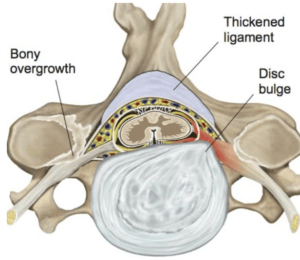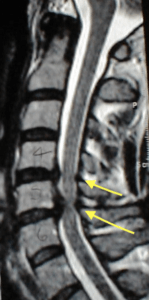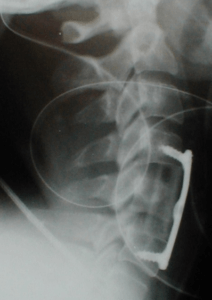Cervical Myelopathy
Introduction
Cervical myelopathy is a neurologic condition involving injury to the spinal cord. The most common cause of cervical myelopathy is cervical stenosis (narrowing of the spinal canal which contains the spinal cord) from arthritic changes of the joints (discs and facet joints) connecting the vertebra. Cervical myelopathy may develop slowly and the early symptoms go unnoticed; more rapid onset or severe myelopathy may include include neck and arm pain, numbness, tingling and sometimes weakness and balance difficulties. Cervical myelopathy is treated with both non operative and operative modalities although only surgery decompresses the spinal cord, prevents progressive injury, and provides the best chance for motor and functional recovery in the presence of structural lesions.
Causes
Most cases of cervical myelopathy are related to stenosis from arthritic changes of the cervical spine which accumulate over the years (cervical spondylotic myelopathy, CSM). These include disc protrusions/herniations, thickened ligaments, and enlarged facet joints and bony spurs (figure 1). Instability in the form of spondylolisthesis can further narrow the spinal canal diameter. There are however numerous other causes for myelopathy including trauma (fractures), inflammation (multiple sclerosis), infections (syphillis, Guillain Bare), vascular (ischemic infarct) and tumor.
Figure 1
Illustration demonstrating cervical stenosis due to thickened ligamentum flavum, bony spur, and disc bulge/protrusion with compression of the spinal cord and left cervical nerve root.

Diagnosis
The diagnosis of cervical myelopathy is made following a detailed history and physical examination by an experienced spine surgeon or neurologist and confirmed with appropriate imaging studies. Mild forms of myelopathy or those with slow onset may go unnoticed by patients delaying diagnosis and may negatively impact outcome. Common symtpoms include neck and arm pain, hand weakness (dropping objects, difficulty opening jars), numbness (difficulty with fine objects and jewelry), lower extremity weakness or balance problems. Physical exam findings include decreased neck motion with pain, especially when looking up, numbness, weakness, poor balance, and abnormal reflexes. Clinical diagnosis is confirmed with imaging studies especially MRI which best demonstrates spinal anatomy and any correlating neurologic compression (figure 2). TMS (transcranial magnetic stimulation) maybe be helpful in confirming presence of myelopathy, identifying multiple sites of compression, or follow up over time. CT myelogram, which involves injecting a contrast dye into the spinal canal to highlite anatomy, can be used for further evaluation or if MRI is can not be performed.
Figure 2
A sagittal section (looking from the side) image of the cervical spine in the midline with MRI demonstrating cervical stenosis and compression of the spinal cord. Arrows demonstrate herniated discs from the front (anteriorly) and the thickened ligaments in the back (posteriorly) “pinching” the spinal cord. Notice the complete obliteration of the fluid filled epidural space producing a severe stenosis at C5/6 and moderate at C4/5.

Non operative treatment
Ultimately, treatment of myelopathy depends on the specific diagnosis although CSM due to stenosis is most common. Patients with mild cervical stenosis with or without myelopathy may benefit from nonoperative treatment. This begins with activity modification to avoid activities that aggravate and inflame the “arthritis” including extension based activities. A soft collar can provide some support with activities that aggravate myeloradicular symptoms. NSAIDs and possible steroid injections including epidural steroids can decrease pain and inflammation and facilitate rehabilitative efforts. Patients with severe pain my require temporary use of narcotics (oxycodone, tramadol, hydrocodone) or muscle relaxants in the presence of muscle spasm. Once the pain and neurologic symptoms improve physical therapy (PT) is very helpful to improve neck motion and strength and increase activities and functional abilities. Therapy also helps educate patients regarding proper body mechanics and posture. PT may also other modalities including ice, heat, ultrasound, TENs unit, and massage. Patients are then instructed in developing a home exercise program that includes core range of motion and strengthening exercises as well as low impact aerobic exercise (swimming, water aerobics, stationary bike, elliptical, etc).
Patients with chronic nerve pain can be treated with “anticonvulsant” medications including gabapentin (Neurontin), pregabalin (Lyrica), topiramate (Topamax) which are thought to act by preventing abnormal increases in brain activity (usually through Na or Ca channels).
Antidepressants such as nortriptyline and duloxetine (Cymbalta) may also be helpful for patients with chronic pain by modulating pain transmission in the central nervous system.
Patients should be educated on the natural history of cervical stenosis, the probability of lesions progressing over time, and the risk for neurologic injury, even paralysis, with progression or trauma. Patients should be re-evaluated on a regular basis, implement fall precautions, and undergoe repeat imaging if new neurologic changes develop.
Operative Treatment
Most patients with cervical stenosis and myelopathy (CSM) especially those with increasing pain, weakness, or functional limitations require surgery which involve removal of the stenotic lesion. Disc herniations are treated by an anterior discectomy to decompress the nerves and or spinal cord and fusion and instrumentation to stabilize the spine, ACDFI (figure 3).
Figure 3
Patient from figure 2 with myeloradiculpathy treated with cord decompression via C5 corpectomy, fusion with fibular strut allograft, and plate fixation C4-6.

Posterior lesions are treated with laminectomy, laminoplasty, or laminectomy with posterior cervical fusion and instrumentation if instability is present. Minimally invasive spine surgery (MISS) is an option in smaller lesions involving less severe stenosis and open approaches for more involved cases. Surgery for spinal stenosis is one of the most successful orthopaedic procedures with good to excellent results in the majority (>90%) of patients. Outcome studies demonstrate similar quality of life (QOL) scores following spinal decompression compared to total hip and knee arthroplasty and superior cost utility (QALY).
Further Information
- Cervical Myelopathy Handout
- View Case Study 12 about 53 yo male with cervical stenosis and myelopathy treated with anterior decompression and fusion
- Read about Spinal Stenosis in Delray Beach and Fort Lauderdale
